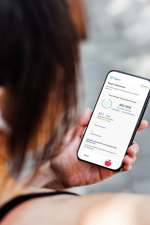
Companies are competing for consumer attention in the digital age. And make no mistake: The businesses that take a data-informed approach to digital experience, one that operationalizes testing and learning, will win the experience game in the end.
So says Cigna Corporation's chief digital and analytics officer, Katya Andresen, who joined the company just over a year ago from Capital One. Andresen describes test and learn as the “manifestation of product development.” It creates value for businesses by creating value for customers.
“Taking a test-and-learn approach means always iterating and working closely with the end user to make sure that what you're developing meets their needs.”Katya Andresen, chief digital and analytics officer, Cigna
“Data is both an input and an output of test-and-learn. It is really important," Andresen explained. "You start with a prototype of your product that was informed by what you already know about your end user. Then you put early versions of it in the hands of your users. You get their feedback continuously and make updates to the experience on an ongoing basis.”
That approach, coupled with machine learning and other technology, has helped Cigna make quick progress of testing and learning. The end result? More personalized and precise experiences that meet individual user needs.
Testing-and-Learning Approach for Musculoskeletal Care
Guided Musculoskeletal Care, a solution being built by Evernorth, Cigna Corporation’s health services business, uses artificial intelligence-backed predictive models to identify customers at elevated risk for MSK surgeries up to a year in advance to engage and guide them to the right care at the right time for their unique conditions and goals. In this instance, the goal with testing and learning was to make sure that the clinical and predictive models helped reach the right customers and encourage them to take certain actions.
“We did a lot of testing and learning when building the solution,” Andresen said. “We needed to make sure that the service works to effectively connect customers to in-person or digital physical therapy, in-network behavioral health providers, and support before and after surgery. We looked at specific use cases – such as those suffering with back pain who were high risk for surgery – and refined our care experience and messaging to make it as easy as possible for people to get the care they need.”
Today, the models review customer data continuously and with a high degree of accuracy to predict surgery. For example, customers at elevated risk for back, knee, or hip surgeries can be identified up to a year in advance with 73% to 92% accuracy, enabling us to help them take action to avoid surgery.
The end result enables us to offer a solution that packages our AI and predictive analytics together for the benefit of our clients and customers. Cigna health plan is leveraging this solution to power Pathwell Bone & Joint, a holistic care experience for people with musculoskeletal conditions that will improve health outcomes while reducing unnecessary surgeries that can lead to increased costs.
A Data-Informed Test-and-Learn Approach to Anxiety and Depression
For people suffering from anxiety and depression, getting help can take time, especially if they are trying to find a mental health care provider for the first time. Cigna is designing an app to connect people with the best behavioral health care providers for them.
Earlier this year, the team at Cigna started using a test-and-learn approach to find ways for its online experience to do a better job of directing people to download the behavioral care app. As part of the process, the team analyzed performance data and customer feedback for insights that could drive improvements to the digital care experience and customer communications. This included testing new communications and strategies to ensure a smooth onboarding process, provider match, and appointment scheduling.
“We wanted to know whether inviting people into our online experience was working to drive app downloads,” Andresen said. “We also wanted to ensure that once people did download the app, it was effective at finding users the care they need. We looked at the user interface and messaging to see how easy it was to schedule an appointment and whether the app ultimately reduces time to care.”
The end result: The team made tweaks to email communications to customers, refined the steps that need to be taken to download the app, and saw engagement improve.
The connectivity between Cigna and its health services business Evernorth means that once we have designed a solid solution through our test-and-learn approach, we can more easily scale our solutions to make a broader impact on the people we serve.
Two Tips for Getting Test-and-Learn Right
Andresen had good advice for companies that would like to lean into testing-and-learning. “You cannot improve what you're not measuring, and you can't measure what you haven't set a clear hypothesis and goal around,” she said.
She also urged business leaders to remember that moving to test-and-learn takes time and is a big culture change: “We have not always done things this way, so there’s a big change that needs to happen in mindset, she said. “Testing, failing, and then learning from that failure can be even more beneficial than getting it right to begin with.”

Harnessing digital innovation to put the care back in health care
Cigna's Katya Andresen is speaking at Reuters Momentum on how companies can unlock the potential of data and digital to bring better, connected care to their customers. Register now to watch her presentation virtually.
